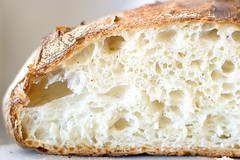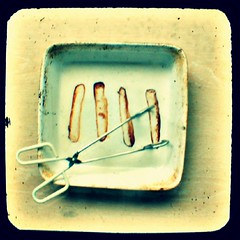Wednesday, 5 November 2008
Breakfast...again
The spreadsheet is well worth a look - it lists sodium contents for breakfast cereals, takeaway breakfasts, toast, coffee...everything you could possibly want, and because it's in a spreadsheet, you can sort it and be suitably shocked at some of the measurements, but also find some good low sodium options.
Tuesday, 27 May 2008
Bread of Heaven...
...bread of heaven...feed me til I want no moooooooore...
Ah, blurry memories of Welsh weddings come flooding back.
Bread seems generally to be high in sodium - and a lot of it is stealth-salt, that you can't really taste. There's a wide range of sodium contents though, and by shopping carefully you can cut back on your intake drastically. If you eat bread, it's likely to be in biggish quantities, so this is something where you do want the sodium level to be low.
Government guidance on sodium is 2.4g per day. See here for more on this.
Of course bread is something that varies hugely between brands and shops...but a quick scan of the shelves locally shows the following sodium contents per 100g...
High:
Honey seeded wheaten bread (which from the name you would expect to be healthy) - 0.96g
Mini brown rolls - 0.6g
Middling:
Soft white rolls - 0.48g
Cholla - 0.48g
Every day white sliced loaf - 0.47g - this is 0.21g per slice
Part-baked baguettes - 0.45g
Baguette - 0.44g
Ciabatta - 0.4g
Tortilla Wrap - 0.36g
Muffins - 0.34g - that's 0.22g in each muffin
Pitta bread - 0.3g
Low-ish:
Teacakes - 0.17g per 100g - my favourites, good to know
Even better, you can make your own salt-free bread! No really, if I can do it, you can too.
Thanks to fuzuoko for the great photo!
Sausages
Sausages, according to the FSA, are chock full of sodium, and have got worse over the last few years, despite the trend towards healthy eating. Looking around our local supermarkets confirmed this, and Googling "low sodium sausages" etc. came back with nothing in the UK, as per usual.
So today I headed to my local farmer's market in search of low sodium sausages. I spoke to four producers, three of whom admitted to using salt-laden "ready made mixes" of spices and seasonings to make their sausages.
One stallholder admitted that the sausages he was selling were too salty for his taste. One lady selling boar products said she made her own sausage seasoning mix, but it still contained high-sounding levels of salt (although it was a quarter of what was recommended in the recipe she uses). She said, however, that she was happy to provide unseasoned sausage meat for me to use to make my own sausages, should we choose to commit ourselves to shelling out for a sausage maker, or make "patties".
The search continues...
Friday, 25 April 2008
Making Bread
The first bit of advice I would give on this is to get yourself a bread machine. I got mine for a few quid from a friend (the lovely Cathie at BecomingDomestic) who was upgrading hers to a larger version, and it has been fab. It's not something that needs to be expensive - I have seen a few on Freecycle and in charity shops. I think it's the sort of thing people get as a wedding present, or in an earth-mother moment, and then never use.
It should come with a recipe book (if you get a second hand one that doesn't, then take a look at the manufacturer's website, as most have lists of instructions for their products nowadays). You can buy ready-made mixes for bread machines, but you will probably end up with bread just as high in sodium as "bought" bread. And to be honest, I don't think that getting the ingredients together is that much more hassle.
Some advice:
- Leave out the salt (obviously). This may affect how your bread rises, so you might need to experiment a bit with quantities of the other ingredients to get it right.
- Use unsalted butter or olive oil.
- If you use use the dough setting (on mine this is 90 mins long), then you can make pizza bases/rolls etc.
- Add extra ingredients - if you find the bread too bland, add some raisins, chilli, garlic or herbs. Be careful not to add them too early though or they will get chopped up too much.
- Fathom out how the timer works, and use it. That way you can wake on a Sunday morning to the smell of baking bread, or if you're making bread rolls in the week then the dough can be ready when you get in from work, ready to put into the oven at the same time as dinner.
This week, I have managed to make Mr. C packed lunches made with sodium-free home-made rolls, and to also knock up some very tasty garlic bread, with roasted garlic. And very virtuous I feel too.
Update: Based of 9 months of experience, I have added some new tips here.
Breakfast Cereals
So we rely on bought cereals. And why not? We stick to the healthier end of the spectrum, avoiding the particularly sugary/chocolatey/delicious ones. Many breakfast cereals make health claims, and it's good to know that for at least that one meal a day, we are guaranteed to get good percentages of various GDAs and vitamins, and a decent dose of fibre. So surely they will be low in sodium too? Disappointingly, the answer is no.
Here's a quick run-down of some of the popular cereals...all figures are g of sodium per 100g. See here for more on recommended sodium/salt levels.
Saltier than Walkers Crisps:
Kelloggs Corn Flakes 0.7g
Kelloggs Rice Krispies 0.65g
Kelloggs All Bran 0.6g
High:
Kelloggs Fruit n Fibre 0.55g
Kelloggs Bran Flakes 0.5g
Cheerios 0.5g
Kelloggs Coco Pops 0.45g
Kelloggs Crunchy Nut 0.45g
Kelloggs Frosties 0.45g
Kelloggs Special K 0.45g
Weetaflakes 0.4g
Middling:
Shreddies 0.3g
Weetabix 0.26g
Low:
Alpen 0.15g
Ready Brek <0.1g
Oatibix 0.15g
Quaker Oatso Simple "Trace"
Quaker Granola "Trace"
Shredded Wheat "Trace"
Shredded Wheat Bitesize "Trace"
Some of those figures are pretty high. In a "serving" of Kelloggs Corn Flakes you'd get half a gram of salt - that's the same as a normal-sized bag of crisps. Generally, the Kelloggs cereals came out high; those at the bottom of the list above are largely made by Weetabix (although you can get an even lower sodium Weetabix-type cereal from Doves Farm at 0.2g).
I took a look at some own-brand versions of the Kelloggs cereals to see if they were any better.
Bran Flakes - Sainsburys 0.6g, Tesco 0.6g
Choco Snaps - Sainsburys ?, Tesco 0.4g
Corn Flakes - Sainsburys 0.6g, Tesco 0.6g
Frosted Flakes - Sainsburys 0.6g, Tesco 0.6g
Um, no, not really! So it's Shredded Wheat and porridge from now on until Kelloggs sort out their act.





